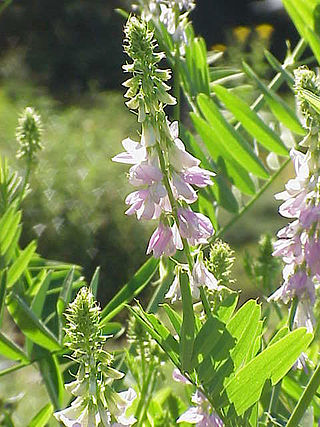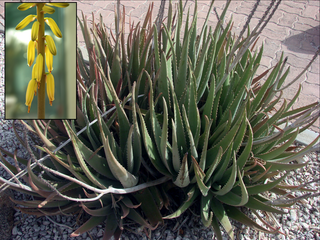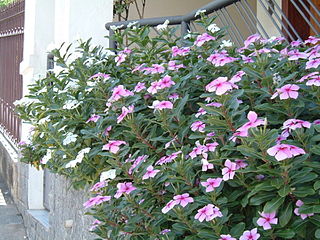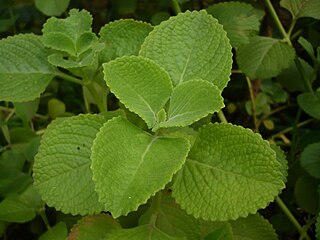
Galega officinalis, commonly known as galega or goat's-rue, is a herbaceous plant in the subfamily Faboideae of the legume family Fabaceae. It is native to parts of northern Africa, western Asia and Europe, but is widely cultivated and naturalised elsewhere. The plant has been extensively cultivated as a forage crop, an ornamental, a bee plant, and as green manure.

Petasites hybridus, also known as the butterbur, is a herbaceous perennial flowering plant in the family Asteraceae that is native to Europe and northern Asia.

Medicinal plants, also called medicinal herbs, have been discovered and used in traditional medicine practices since prehistoric times. Plants synthesize hundreds of chemical compounds for various functions, including defense and protection against insects, fungi, diseases, and herbivorous mammals.
Costus barbatus is a critically endangered species of plant native to Costa Rica.

Aloe vera is a succulent plant species of the genus Aloe. It is widely distributed, and is considered an invasive species in many world regions.

Costus is a genus of herbaceous perennial plants in the family Costaceae, erected by Linnaeus in 1753. It is widespread through tropical and subtropical regions of Asia, Africa, and the Americas.

Costus osae is a species of flowering plant in the family Costaceae. One of many rare tropical plants in the Costus family, Costus osae is a species native to Costa Rica described in 1997. It has also been reported from Colombia.

Equisetum myriochaetum, also known as Mexican giant horsetail, is a species of horsetail that is native to Nicaragua, Costa Rica, Colombia, Venezuela, Ecuador, Peru and Mexico. It is the largest horsetail species, commonly reaching 15 feet (4.6 m), with the largest recorded specimen having a height of 24 feet (7.3 m). At each node is a whorl of as many as 32 branchlets. It is semi-aquatic and is often found growing on riverbanks.

Costus spicatus, also known as spiked spiralflag ginger or Indian head ginger, is a species of herbaceous plant in the Costaceae family.

Ichnocarpus frutescens is a species of flowering plant in the dogbane family Apocynaceae, known by the English common name black creeper. It is native to much of China, India, Southeast Asia, and northern Australia.

Clerodendrum glandulosum, commonly known as East Indian glory bower, is a perennial shrub belonging to the family Lamiaceae, but sometimes classified under Verbenaceae. It is one of the most well known among ~400 species of Clerodendrum, as it is widely used in traditional practices, such as for vegetable and treatments of diabetes, hypertension, cough and rheumatism.

Dominican tea culture combines many customs adapted from various colonial and immigrant cultures that have mingled in Dominica. "Bush teas", made from local herbal plants and often taken for medicinal purposes, are a traditional part of Dominica's culture.

Coleus is a genus of annual or perennial herbs or shrubs, sometimes succulent, sometimes with a fleshy or tuberous rootstock, found in the Afro-Eurasia tropics and subtropics.
Costus curvibracteatus is a tropical rhizomatous perennial native to Costa Rica and Panama.

Ina Vandebroek is an ethnobotanist working in the areas of floristics, ethnobotany and community health. Since 2005, she has worked at the New York Botanical Garden in the Institute of Economic Botany. She has worked on ethnobotanical projects in North America, the Caribbean, and South America.

Costus pulverulentus, the red cigar or spiral ginger, is a species of flowering plant in the family Costaceae. It is native to Mexico, Central America, Colombia, Venezuela, and Ecuador, and it has been introduced to Cuba and Florida. It is invasive in Hawaii.

Costus lucanusianus is a species of plant native to Africa. It is widely distributed across North East Africa, West Africa, Central Africa, East Africa, and Southern Tropical Africa.

Costus afer, English ginger lily or common ginger lily, is a species of plant native to Tropical Africa.
Costus scaber is a species of plant in the Costaceae family. Its native range is Mexico to Tropical America.

Costus productus, known as Orange Tulip Ginger, Dwarf Orange Ginger, or Green Mountain Spiral Flag, is a species of plant in the Costaceae family. Costus productus is native to South Colombia and Peru.
















